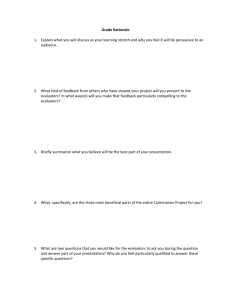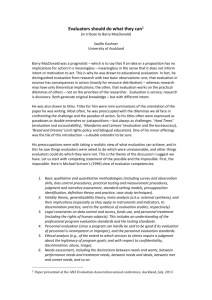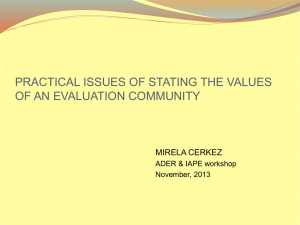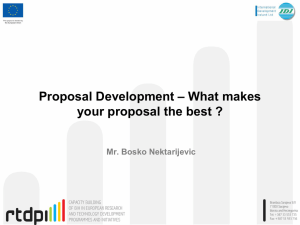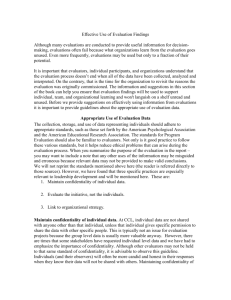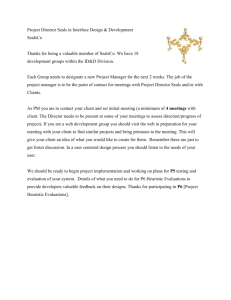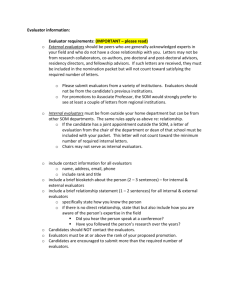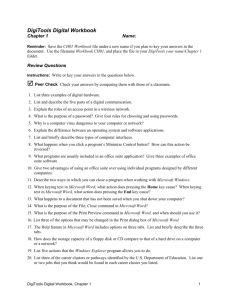conclusions - PREP Panel
advertisement
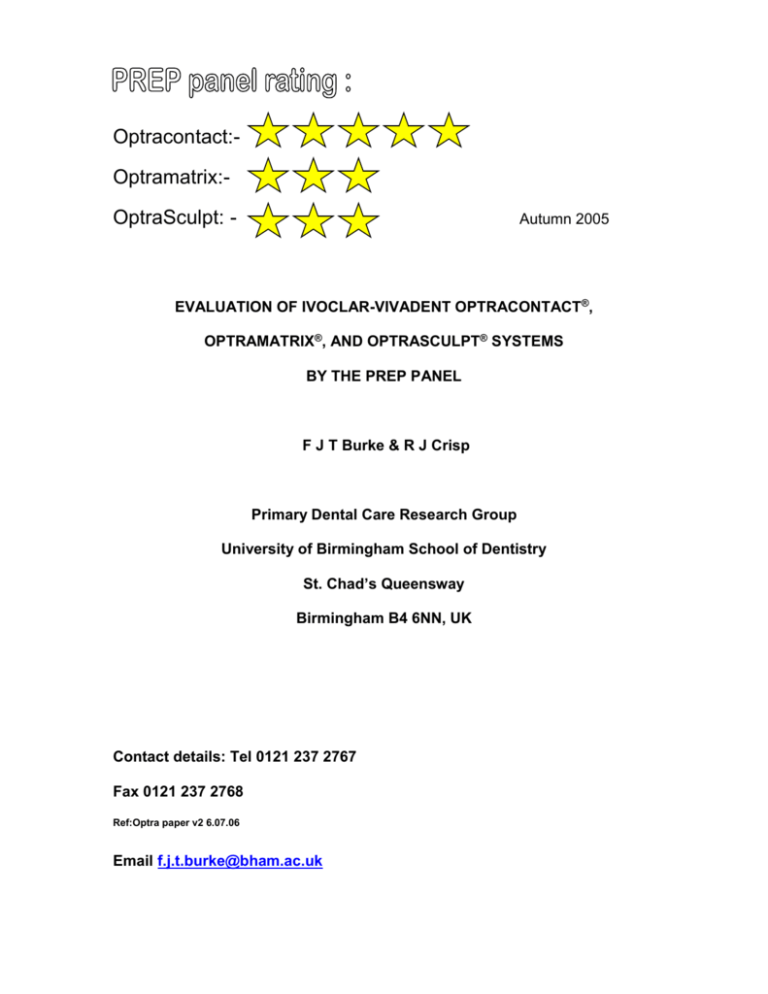
Optracontact:Optramatrix:OptraSculpt: - Autumn 2005 EVALUATION OF IVOCLAR-VIVADENT OPTRACONTACT®, OPTRAMATRIX®, AND OPTRASCULPT® SYSTEMS BY THE PREP PANEL F J T Burke & R J Crisp Primary Dental Care Research Group University of Birmingham School of Dentistry St. Chad’s Queensway Birmingham B4 6NN, UK Contact details: Tel 0121 237 2767 Fax 0121 237 2768 Ref:Optra paper v2 6.07.06 Email f.j.t.burke@bham.ac.uk r.j.crisp@bham.ac.uk INTRODUCTION Good handling of newly-developed materials and devices is essential if these are to be of value to dental practitioners and their patients, and it was with this in mind that the practitioner research group, the PREP (Product Research and Evaluation by Practitioners) Panel was established in 1993. This group, which now comprises 28 general dental practitioners from all areas of the UK, has completed almost 50 evaluations of the handling of dental materials and is involved in the medium-term clinical evaluation of four dental restoratives. A range of novel devices (Table 1) intended for use in the placement of, principally, resin-composite restorations, has recently been introduced by the Liechtensteinbased dental manufacturing company Ivoclar-Vivadent UK (UK contact: Compass Building, Feldspar Close, Warrens Business Park, Enderby, Leicester LE19 4SE, tel: 0116 284 78 80, Website: www.ivoclar.co.uk. It is therefore the aim of this paper to describe the views of the PREP Panel members who evaluated OptraContact, OptraMatrix and OptraSculpt on the handling and performance of these devices. Another paper will cover the evaluation of OptraGate & OptraDam. Table 1 Product Descriptions: 1. OptraContact (Figures 1 & 2) is a hand instrument to aid contact point formation in the placing of Class II composite restorations. 2. The OptraMatrix system (Figure 3 & 4) consists of 6 different thinned matrix bands for use with a Tofflemire matrix retainer. 3. The OptraSculpt instrument & tip system (Figures 5, 6,& 7) consists of 2 stainless steel/plastic sterilisable instruments for use with 6 different disposable tips to model composite restorative materials before curing. 2 METHODS A questionnaire was designed to test the views on the ease of use of the Optraline devices. Explanatory letters, questionnaires and the Optraline systems were distributed in August 2005. The practitioners were asked to use the materials and return the questionnaire by the end of September. Twelve members of the PREP panel were selected at random for participation in this evaluation. Two were female. The average time since graduation was 22 years, with a range of 10 to 37 years. RESULTS: 1. Clinical evaluation of OptraContact and the OptraMatrix systems All (100%) of the evaluators placed composite restorations in posterior teeth. Of these the proportions were: Occlusal 45% Class II 34% MOD 21% The evaluators used a wide variety of matrix systems prior to the evaluation, 20% being sectional and 80% being of circular design. When asked to describe how the evaluator achieved a good contact point, the most commonly used technique involved a combination of wedging and use of an instrument, such as a ball burnisher, to apply pressure to the contact area of the band. (One quote:“I struggle!”) The ease of use of the currently used matrix system was rated as follows: 3 Difficult to use 1 5 Easy to use 3.4 The evaluators rated the percentage of contact points with which they were entirely satisfied as 74% (range 10 – 95%). Evaluators rated the presentation of the OptraMatrix kit as follows: Poor 1 5 Excellent 4.0 Comments made to improve presentation included: “Matrices should come in dispenser i.e press and one should be delivered – no fiddling about getting one out of a section” “Could they be colour coded?” “Contact/Matrix should be all in one kit with good illustrations + a DVD” When the evaluators were asked to rate the illustrated technique guide/instructions for OptraMatrix and OptraContact the results were as follows: a) OptraMatrix Poor 1 5 Excellent 3.1 Comments made included: 4 “Larger print , more detail and use colour” (7) b) OptraContact Poor 1 5 Excellent 4.0 Comments made included: “Use colour and larger pictures” (2) A total number of 303 posterior composite restorations were placed using the OptraContact & OptraMatix systems. All 100% of the evaluators stated there were sufficient sizes of matrix bands in the kit. Seven evaluators (58%) stated that bands occasionally tore on tightening. Comments made describing difficulties with the OptraMatrix system and the OptraContact instruments included: “Practice helps “There is too much choice” “OptraContact is superb – used it all the time” “Difficult to place – disincentive to use” (3) “Initially difficult but familiarity breeds satisfaction” (2) “Initially struggled with orientation & when contacts tight” The evaluators rated the ease of use of the OptraMatrix system and the OptraContact instruments as follows: 5 a) The OptraMatrix system Difficult to use 1 5 Easy to use 5 Easy to use 2.7 b) The OptraContact instruments Difficult to use 1 4.3 The evaluators rated their satisfaction with the results obtained using the two systems as follows: Not satisfied 1 5 Very satisfied 3.6 Seven evaluators (58%) stated that they would not purchase the OptraMatrix system but 11 evaluators (92%) stated that they would purchase the OptraContact instruments. Eight evaluators (67%) would recommend the OptraMatrix and OptraContact systems to colleagues. Comments made about these two systems included: “OptraMatrix has taken thinness too far” “OptraContact is a brilliant invention & gives predictable results” “An overdue and long awaited system” “Does give tight contacts” “I need more practice – easily torn, but overall a big improvement” “OptraContact would be better if it had a curved end – it produces a flat contact point with a straight wall beneath” 6 “Recommend OptraContact – now use routinely” “Make OptraContact heavier – better handles & more ‘feel’” CONCLUSIONS The OptraContact instrument and the OptraMatrix system have been subjected to an extensive clinical evaluation in which 303 posterior restorations were placed. The OptraContact instrument scored well for ease of use and its success was underlined by the statement that 92% of the evaluators stated that they would purchase it. The OptraMatrix system scored slightly less well for ease of use than the matrix system used previously (2.7 v 3.4 on a visual analogue scale where 1 = difficult to use and 5 = easy to use) but the evaluators who persevered with the system stated that they were satisfied and obtained good results. 2. The Ivoclar-Vivadent OptraSculpt instrument and tips Evaluators used a wide variety of instruments for the placement and pre-cure contouring of resin composite restorations, the most commonly used being a ball burnisher, flat plastic and Ward’s carver. Three (25%) of the evaluators routinely used rubber dam when placing composite restorations. Operators also used a wide variety of composite restorative materials. The ease of use of the currently 7 used placement and pre-cure instrument system for composite materials was rated by the evaluators as follows: Difficult to use 1 5 Easy to use 3.6 The evaluators rated the presentation of the OptraSculpt kit as follows: Poor 1 5 Excellent 4.2 Comments made included: “Too many components” (2) “ ? A dispenser for infection control?” (2) When the evaluators were asked to rate the illustrated technique guide/instructions for OptraSculpt the results were as follows: Poor 1 5 Excellent 3.7 Comments made included: “Use colour and larger pictures” (4) “Use better line drawings demonstrating the use of each tip precisely” A total number of 235 restorations were placed using the OptraSculpt system. 92% (n=11) of the evaluators stated that the OptraSculpt instrument was “about right” regarding both weight and grip. Eight (67%) of the evaluators stated that the tips were easy to identify and place on the instrument. 8 Comments made included: “Easy to place but not easy to identify tips until used to their position in the box” (4) “Too many components” (3) Nine (75%) stated that there were sufficient designs of tips included in the kit. The remaining evaluators stated: “Would like a rounded point end” (see scan of design below) “Wanted a smaller diameter cylinder” The table below indicates which tips were most useful and the average usage for each tip. Tip Number of evaluators Percentage use per shape using tip restoration (range) Cylinder 9 68 (20-100) Chisel 7 53 (5-100) Spatula 8 76 (20-100) Sphere 8 81 (10-100) Point 12 51 (5-100) Pyramid 5 17 (10-30) The evaluators rated the ease of use of the OptraSculpt system as follows: Difficult to use 1 5 Easy to use 4.0 9 58% (n=7) of the evaluators stated that they would purchase the system and 67% (n=8) that they would recommend the system to colleagues. Final comments on OptraSculpt included: “ Relieved to find a surface which composite doesn’t stick to” “How about having the tips in a line in a block so that you just inserted the handle and removed one at a time” “May be good for high end aesthetic work” CONCLUSIONS The OptraSculpt pre-cure composite modeling instrument & tip system have been subjected to an extensive clinical evaluation in which 235 restorations were placed. The OptraSculpt system scored better for ease of use than the placement & modeling system used previously (4.0 v 3.6 on a visual analogue scale where 1 = difficult to use and 5 = easy to use) and the majority of evaluators would both purchase the system and recommend it to colleagues. Suggestions were made to improve the system, which would perhaps further enhance its acceptability. MANUFACTURER’S COMMENTS Two years after the introduction of the OptraContact instrument, about 40,000 dentists are already using it on a regular base. Since the broad introduction of composites in the 80s, to build up an anatomical proximal contact has become a daily challenge for dentists all over the world. The second solution for getting tight contacts is offered with the partially thinned OptraMatrix. The OptraMatrix is 10 a high technology product, manufactured with a technology called “micro etching.” Its development took more than half a decade. The OptraMatrix and the OptraContact perform excellent together but can be used as standalone products without restrictions as well, depending on the personal preference. Whereas the OptraMatrix and the OptraContact are interesting for nearly every dentist, the OptraSculpt will find its friends among the users of high aesthetic composites primarily, as these materials are more “sticky” than universal composites. The OptraLine, innovative accessories and instruments from Ivoclar Vivadent, will be extended through the following years with many more simple but highly effective product solutions for dentists all over the globe. Footnote: OptraContact®, OptraMatrix® and OptraSculpt® are registered Trademarks of Ivoclar Vivadent AG. 11
